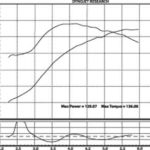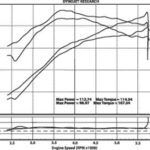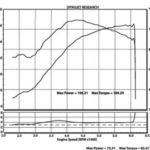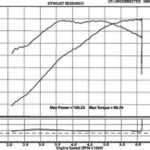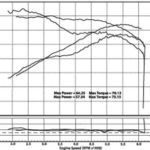Last time, we defined “stages” of performance and hopefully put to bed the notion that displacement equals efficiency. It doesn’t! Some random examples of various stages applied to various displacements might just clarify things a bit further. Mind you, this treatise isn’t intended to be extensive, only illuminating!
But before we go on, let’s be clear about this much in advance: As much fun as it is to talk about both inches and ponies, neither means a damn thing out of context—as in power-to-weight, or volumetric efficiency.
Let’s also be clear that horsepower by definition is nothing more than torque multiplied by engine revolutions (rpm), which leads to the inescapable conclusion that the engine making the most of the former will also make more of the latter—if it can rev well.
As an adjunct to all this, it should be noted that two engines may very well make a maximum of 90 whp at redline, but the one that makes the highest percentage of that peak power at half the peak revolutions will outrun the other—period!
As true as the previous tenet regarding effective engines is, it should then follow as night the day that a good big ’un will beat a good li’l ’un every friggin’ time!
Playing the percentages
We gotta start somewhere, so why not with this? A 55″ XL883 gives us just shy of 0.8 bhp per cubic inch of displacement. That’s 44 whp for those without a calculator. Small perhaps, but more efficient, as delivered, than its air-cooled brethren. A stock XL1200 (74 inches) will give around 52 bhp at the rear wheel, pretty much amounting to about 0.7 bhp/ci. On the other hand the last of the 1340cc Evos (82 inches) will show just under 50 bhp at the rear wheel, stock, which is only 0.6 bhp/ci (while California models managed a sad 42 bhp, barely over a half horse per inch). Twin Cam 88s with 1,550cc to offer generated a typical 60–62 whp, or close to the same efficiency as the 74″ Sporty. All the same, as delivered, the new 96″ Twinkies aren’t really making any more horses than the original 88-incher, let alone 95″ “conversions.” More torque, yes; more horsepow-er, no.
Yet the argument typically goes like this: If the little Sportster is happy at 0.8 whp/ci then all the others should also be OK doing at least that well. So the minimum that should be available from the 1340—if it is as “efficient” as the 1200—is 57 whp. Twinkies ought to manage 70–72 whp under the same supposition. But this is 20 percent more than we were/are being given. (Part of the reason for that is the Evo Big Twin is less efficient in its combustion processes than the Sportster or the Twin Cam.) So if the factory doesn’t make Big Twins as efficient as they could, is it unreasonable to believe that the Sportster engine(s) may not be perfection personified either? Of course it isn’t—and output figures from the Buell twins prove it can be better.
That’s where it starts, and it leads to the quest for at least 1.0 whp/ci of engine displacement in street motors. Totally doable, but not quite like falling off a log and not without trade-offs and sacrifices.
Now just what sort of numbers should you expect from different engines and different sizes?
We’ve already seen there is no magic forthcoming from engines that are simply bigger—beyond that which their extra size can develop. In other words, if a 1200cc engine produces 60 bhp, then a 25 percent larger 1500cc engine (providing, of course, that intake/cam/ignition/burn/exhaust etc. are all 25 percent more efficient, too) will manage 75 bhp. No magic, only simple math. But simple math might not be so simple when you want to improve, let alone double, the factory output, since those last small increments of efficiency come mighty hard if at all on certain engines. Ah! Then it really comes down to extracting “potential” doesn’t it?
Overachiever or underachiever; that is the question
Needless to say, doubling output on any engine is a neat trick and in the case of a Harley, producing over one horse per inch adds a lot of stress and strain to everything downstream as well. Things like clutches and starters may need more help than the power plant proper to get it to the ground reliably. All the same, helping the power plant achieve its potential is the name of this game and the many paths it can take to get to the destination make for interesting studies. So, let’s study some now! (Oh, yeah, “your results may vary,” as the disclaimer goes… and in fact, probably should.)
80″ Evos have at least two strikes against them going in: a comparative lack of inches and alleged inefficiencies in the breathing department. This one has overcome both pretty well, with a mostly factory “Stage IV Eliminator” package. It manages to generate well over 1.0 whp/ci of displacement—almost double its stock output! Call this one an overachiever! The biggest issue here is the exhaust, which causes both the dip in torque as well as the flattening of the curve above 3,500 rpm. A solution to the bottleneck created by the pipe would let quite a few more ponies outta the corral. (Remember, more torque also equals more horsepower?) It cannot be overemphasized that pipe choice can absolutely make or break an engine’s output, regardless of how slick other component choices may be.
Just for fun let’s consider 1.0 whp/ci as being 100 percent efficient—whole hog, as it were! Well, here we have a TC88 at stage two, with S&S 510 gear drive cams, and a real boner of an exhaust choice! Namely, true dual headers (good on their own) screwed by the addition of fishtail drag mufflers. With 10 percent more displacement than the Evo, it can’t manage more than 0.7 whp/ci and a torque curve that just gets worse from 3,000 rpm on up. In short, the pipe kills the cam—and almost ruins the whole plan. All the parts, time and effort for a net loss! Make a note: Twinkies like this—with 10 percent more displacement and factory-supplied 12–15 percent efficiency advantages nullified—are a well “staged” Evo’s lawful prey! At no point does the bigger, newer engine enjoy any superiority in power output.
Another 88″ Twinkie at stage one, but with a huge difference: true duals featuring 2″ headers and muffs you can see through! No cam change at all, yet the exhaust choice has made this package work really well; all in all a neat way to pick up 16 whp and 9 ft/lbs of torque—where it can be used most. (The gains are even more impressive when you realize this engine made less power stock than our last example.) Here stage one offers 80 percent efficiency and—more importantly than mere power—a near-perfect power band. This engine is making 10 ft/lbs more torque and 8 whp more at 3,500 rpm than the other 88-incher with fishtails.
Here’s what an intelligent aftermarket stage three setup coupled with a 95″ big-bore can do for an early Twinkie engine. Welcome to the 100 hp club! Flowed heads, Kuryakyn Wild Things (TC-2) gear drive cams, Rinehart true duals, Arlen Ness Big Sucker Stage Two, Dyno Jet Power Commander to bring it all into the proper air/fuel zone and bam! (Note the flat, absolutely spot-on air/fuel ratios at the bottom of the chart. That’s actually the object of the game with any “combo.”) Hard to say exactly what specific little thing puts it over the top, but bottom line, this is the first engine that approaches the stage four Evo, at over 1.0 whp/ci and over 100 percent efficiency. A good big ’un that will indeed beat that good li’l ’un! On paper, at least. Considering the Evo hauls about 775 lbs of bike and rider but the TC is saddled with a couple hundred more pounds of payload, the outcome of any race based on power-to-weight is less assured than the charts make it seem.
As mentioned, 96″ Twinkies don’t come with the extra horsepower to go with the extra displacement. (Gee thanks, EPA!) But they do make more torque—like an extra 12 ft/lbs right where ya want it! You augment this by doing a stage one correctly, mostly adding true duals with 2″ diameter headers, a stage two air cleaner, and proper EFI mapping, and get results pretty much like this. The raw numbers as well as the percentages of net gain are plenty enough for most of us, what with a very broad increase everywhere, peaking at an extra 15 ft/lbs of torque and near 18 whp! There’s still 20 percent “in the hole” here, but that can be had later.
Here’s pretty much the same setup, but with the addition of a great two-into-one exhaust. Torque peaks early, and there’s a nudge more of it, which then falls off fairly quickly as rpm builds. This time around it’s not the exhaust causing it, it’s the stock cams. The fully hotted-up Evo still has some edge—15 percent less displacement but virtually the same torque and 9 whp more—but this is a classic example of how stage four from an earlier era equates to a current stage one.
So, we’re off to stage two—but with a twist! The addition of TC-2 bolt-in cams (gear drives not mandatory on 96-inchers) along with all the previous stage one mods and the all-important addition of an S&S “self learning” closed-loop ECU to the EFI system gets you a few extra horses to be sure, but mostly it allows the engine to keep making torque farther up the rev range. That’s actually where the extra peak power comes from. This may well be the optimum state-of-the-art setup for 99.9 percent of us. The traditional trade-offs are virtually nonexistent, the benefits enormous and the sheer overall rideability improvements obvious—once you’ve ridden a bike thus equipped and tuned. (A real arm-straightener once you hit three grand, too!)
Just so you know, stage three for a 103″ SE engine most certainly shows an edge over the stage two 96-incher. But it would appear we have crept up close to the law of diminishing returns, as well. To get that magic one pony per inch outta this engine, CNC heads and S&S 585 cams were necessary. I can’t help but observe that, again, a poor choice of exhaust has hobbled this monster to some degree. Sure, it’s making plenty of torque from about 3,200 rpm on up, but compare that to the torque output at the same (or lower) revs in some of the smaller combos with true duals or two-into-one pipe choices. Then imagine the same type of flat curve on this 103! Could also be the cams don’t start to work quickly enough. In short, as nice and nasty as it is, this engine points out two things at once: It bats the bejesus outta the stock 103 motors, yet still leaves an awful lot on the table below four grand on the tach.
By way of proving what fine-tuning alone can accomplish, here’s a before and after on a JIMS/SE 120″ motor. Technically stage four, this engine also has pipes that don’t help all that much, but simply getting the air/fuel ratio on target has helped the output of this “package” immensely! Think about it for a moment: No changes in hardware at all—simply getting the most out of what’s there—adds 6 ft/lbs of torque to the arsenal along with nearly 14 whp, most of which is showing up at half throttle (or at “cruise,” if you prefer). Yet, even with impressive levels of power, this engine is only about 0.9 whp/ci.
Contrary to what you might read in the funny papers, huge horsepower and torque numbers simply don’t come easy. You might like to believe everything you read, and hide behind crankshaft horsepower “potential” whilst bench racing, and that’s fine. Just don’t come crying to me when those paper ponies get their fannies flogged but good by something a little more realistic—like this! If you ever experience an angry encounter with a healthy, properly tuned 124, you might want to have your excuses for losing worked out in advance. No, it doesn’t make 1.0 whp/ci—not quite! No, it doesn’t have perfect air/fuel ratio at all rpm and throttle positions. It’s just that in spite of any flaws, you won’t run in front of one of these on anything else for long. Partly, that’s because these are born race engines that can afford some detuning, not smog engines that must be tuned up! Partly, it’s because it’s so enormous. But, perhaps mostly, it’s because even if you ignore displacement and efficiency, and simply concentrate on power-to-weight, you soon realize that if weight is a constant, this kind of power makes it seem pretty variable!





